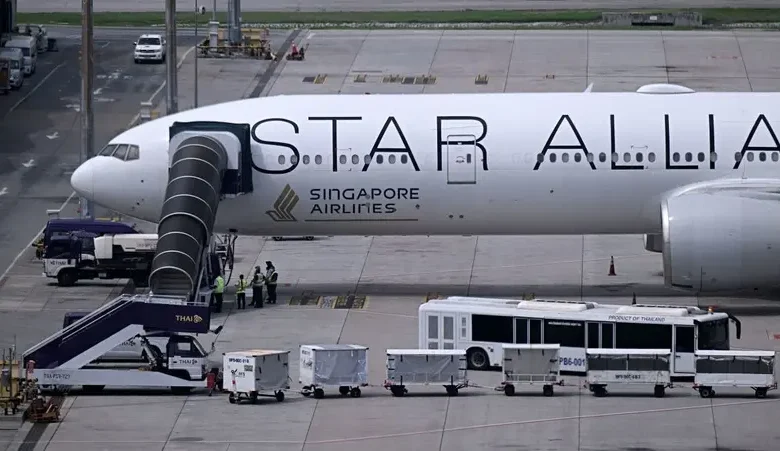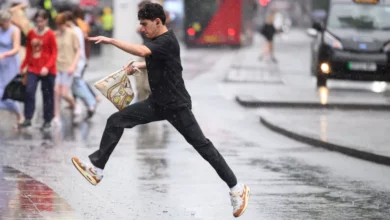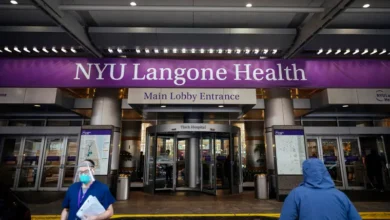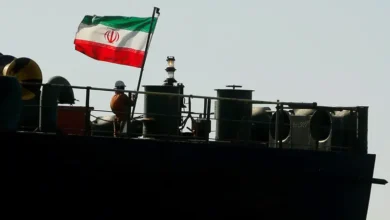20 passengers in intensive care after deadly turbulence on Singapore Airlines flight

Twenty people were in intensive care in Bangkok hospitals on Wednesday after a terrifying high-altitude plunge on a flight from London during which an elderly passenger died and more than 100 people were injured.
Singapore Airlines flight SQ321 hit “sudden extreme turbulence” over Myanmar 10 hours into its journey to Singapore on Tuesday, abruptly rising and plunging several times.
One passenger said people were thrown around the cabin so violently they put dents in the ceiling during the drama at 11,300 metres (37,000 feet), leaving dozens with head injuries.
Photos from inside the plane show the cabin in chaos, strewn with food, drinks bottles and luggage, and with oxygen masks dangling from the ceiling.
The plane, carrying 211 passengers and 18 crew, made an emergency landing at Bangkok’s Suvarnabhumi Airport, where medical staff used gurneys to ferry the injured to ambulances waiting on the tarmac.
“I was flung up to the roof and then as the plane dropped forward so did I,” one passenger told Australian media on Wednesday after arriving in Sydney.
“I then hit the floor quite hard and all the breakfast items and glass flew forward as well.
“The poor crew was preparing breakfast for everyone, so they got the worst injuries.”
A 73-year-old British man died and 104 people were injured on the flight.
A hospital in Bangkok said on Wednesday that its staff were either treating or had treated 85 of those injured, including 20 people taken to intensive care units.
The 20 were from Australia, Britain, Hong Kong, Malaysia, New Zealand, Singapore and the Philippines, Samitivej Hospital said, without specifying how many were passengers or crew.
‘Awful screaming’
A relief flight carrying 131 passengers and 12 crew landed at Singapore’s Changi Airport on Wednesday morning.
Relatives greeted the arrivals with hugs, but all were too shaken to talk to waiting reporters.
Andrew Davies, a British passenger aboard the Boeing 777-300ER, said that the plane “suddenly dropped” and there was “very little warning”.
“During the few seconds of the plane dropping, there was an awful screaming and what sounded like a thud,” he said, adding that he helped a woman with a “gash on her head”.
“Remembering the plane now — the huge dents in the roof that people had obviously hit with their head. There was a water bottle stuck in a gap in the ceiling,” he said.
Singapore Airlines Chief Executive Goh Choon Phong said Wednesday the carrier is “very sorry for the traumatic experience” and expressed condolences to the family of the deceased.
Singapore Prime Minister Lawrence Wong sent his “deepest condolences” to the family and loved ones of the dead man — identified as Geoff Kitchen, a musical theater director from near Bristol.
‘Crazy flight’
Singapore’s transport minister Chee Hong Tat posted on Facebook that investigators from the city-state arrived in Bangkok Tuesday night.
Since the incident involved a Boeing plane, he said, a team from the US National Transportation Safety Board (NTSB) would be sent as well.
An AFP photographer saw people in Singapore Airlines yellow vests entering the plane on Wednesday as it remained grounded in Bangkok.
The Philippines’ Department of Migrant Workers meanwhile said five injured Filipino passengers were being treated at Bangkok hospitals, including a two-year-old boy and a woman who “suffered a neck fracture”.
Malaysia’s foreign ministry said nine of its nationals were hospitalized, including one in a critical but stable condition.
Of the passengers, 56 were Australian, 47 British and 41 Singaporean, according to the airline.
“In terms of exactly what happened, it’s too early to tell. But I think passengers are too casual on board commercial aircraft,” US-based aerospace safety expert Anthony Brickhouse said.
“The moment the captain turns off the seatbelt sign, people literally unbuckle.”
Davies, the passenger, said “the plane suddenly dropped” at the very moment a seatbelt sign came on.
Allison Barker said that her son Josh, who was aboard the plane, texted her that he was on “a crazy flight” that was making an emergency landing.
“It was terrifying,” she said. “I didn’t know what was going on. We didn’t know whether he’d survived, it was so nerve-racking. It was the longest two hours of my life.”
Scientists have long warned that climate change is likely to increase so-called clear air turbulence, which is invisible to radar.
A 2023 study found the annual duration of clear air turbulence increased by 17 percent from 1979 to 2020, with the most severe cases increasing by more than 50 percent.










